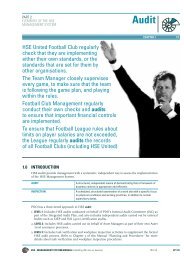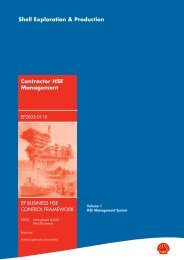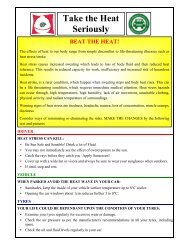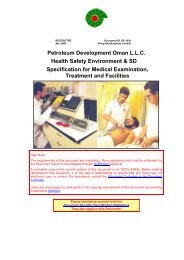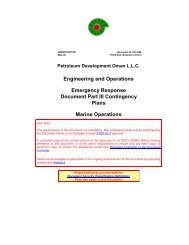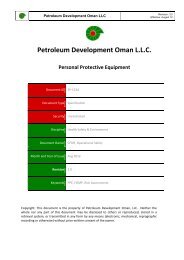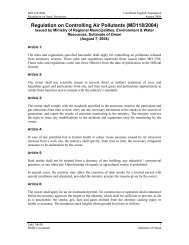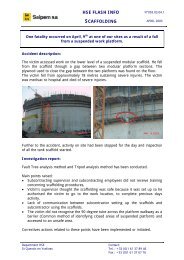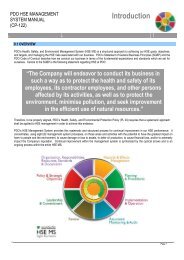CP-122 HSE Code of Practice - PDO
CP-122 HSE Code of Practice - PDO
CP-122 HSE Code of Practice - PDO
Create successful ePaper yourself
Turn your PDF publications into a flip-book with our unique Google optimized e-Paper software.
HEALTH, SAFETY AND ENVIRONMENT<br />
CODE OF PRACTICE (<strong>CP</strong>-<strong>122</strong>)<br />
<strong>PDO</strong> <strong>HSE</strong> Management System Manual<br />
Recovery measures can reduce the likelihood or probability that the first hazardous event will develop into further consequences<br />
and provide life saving capabilities should the „top event‟ escalate further. To assist with recovery, it is important that all<br />
personnel are fully briefed and drilled as to the response measures planned, including evacuation and restoration procedures.<br />
For major incidents, this may include also crisis management and business continuity planning.<br />
4.6.1 Scope <strong>of</strong> Recovery<br />
Recovery should include:<br />
<br />
<br />
<br />
<br />
All activities, products, and/or services controlled by <strong>PDO</strong>, and those influenced by <strong>PDO</strong>, such as supplier, contractor, and<br />
sub-contractor activities.<br />
The activities, products, and/or services carried out by all personnel having access to the workplace and facilities at the<br />
workplace including suppliers, contractors, and/or sub-contractors.<br />
Routine (frequently performed), non-routine (infrequently performed), and/or emergency operating conditions and activities.<br />
Sometimes the categories <strong>of</strong> normal and abnormal operating conditions are also considered.<br />
The lifecycle <strong>of</strong> an asset or activity, from the planning stage, through operation to decommissioning, and disposal and<br />
restoration.<br />
In developing recovery measures, consider and include both active (e.g., emergency shutdown procedures, automatic blowdown<br />
systems, alarms, fire protection) and passive emergency preparedness and response arrangements (e.g. emergency response<br />
call out and duty rosters) for both operational and contingency planning (abnormal situations and potential emergencies). Refer<br />
to Chapter 5 <strong>of</strong> this Manual “Planning and Procedures” for more details about emergency preparedness and response.<br />
For effective recovery procedures it is important that each recovery measure be accompanied by formal documentation. For<br />
instance, each action that should be taken in the event that a control fails shall be documented. In addition, the persons<br />
responsible and/or accountable for establishing, maintaining, implementing, and reviewing each associated procedure shall be<br />
defined and competent.<br />
Effective recovery procedures also require testing and review. For instance, all procedures for recovery from high risk and<br />
emergency scenarios shall be in place and subject to testing and defined review periods. In between the defined review periods,<br />
recovery procedures should be reviewed, and possibly updated, for the following situation:<br />
<br />
<br />
<br />
<br />
An incident has occurred.<br />
Following analysis <strong>of</strong> drills and testing.<br />
Any changes in the operational environment occur.<br />
There are changes in legal and other requirements and/or industry best practice.<br />
Performance against all recovery procedures should be recorded and formally reviewed periodically. Such performance may be<br />
linked to Company, Asset, and/or local goals, objectives, and/or targets. Parties responsible and accountable for implementing<br />
recovery procedures shall be competent to do so and clearly understand their roles, responsibilities, and accountabilities.<br />
4.6.2 HEMP Tools - Recovery<br />
Experienced personnel can construct a bow tie diagram as part <strong>of</strong> a hazard analysis<br />
(HAZAN) and use this to consider the chain <strong>of</strong> events resulting from a top event and the<br />
recovery measures required to reduce the probability and effect <strong>of</strong> each consequence.<br />
Knowledge <strong>of</strong> experienced personnel is invaluable for hazard identification and analysis /<br />
assessment, particularly coming from direct feedback from incidents, accidents, near<br />
misses, and/or hazards.<br />
Procedures for recovery from high risk and emergency scenarios should be in place and<br />
subject to drills, testing, and review. Creating simple checklists and/or Work Instructions,<br />
based on procedures, clarify and expedite response in real emergency situations.<br />
All control and recovery procedures should be established, included, and recorded in the <strong>HSE</strong><br />
Management System, an <strong>HSE</strong> Case, MOPO, and/or Job Safety Plans with recovery actions that should<br />
be taken in the event a control fails being documented.<br />
July 2011 Page 35




